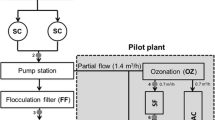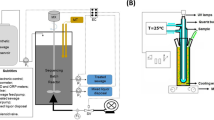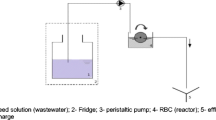Abstract
17β-Estradiol (E2) is a natural estrogen produced by the feminine endocrine system. It is excreted mainly through urine and feces. Exposure to E2 may affect the reproductive system of both animals and humans, especially since the removal of E2 in conventional processes and technologies present in the wastewater treatment plants is not sufficient. Chlorine is one of the most studied and used oxidant worldwide. Although there are studies that demonstrate the endocrine disrupting compounds removal like E2, its reaction with organic matter can originate by-products, namely, trihalomethanes, which are known to have high toxic potential. The main aim of the present study was to evaluate the removal of E2 (50 μg E2 L−1—maximum concentration) using peracetic acid (PAA), a seeming cleaner and innocuous alternative to chlorine. To this end, a series of jar tests were performed, using different peracetic acid concentrations (1, 5, 10, and 15 mg L−1) and contact times (10, 15, and 20 min). The results obtained showed that a peracetic acid concentration of 15 mg L−1 with a contact time of 20 min had a removal efficacy of approximately 100%. The second main goal of this study was to evaluate the ecotoxicological potential of the tested treatments on the zebrafish Danio rerio. Several oxidative stress biomarkers were evaluated, namely glutathione S-transferase, lipid peroxidation, and catalase, besides vitellogenin. Both peracetic acid and E2 caused significant increases in the oxidative stress biomarkers, although this did not lead to increased lipid peroxidation levels. In addition, peracetic acid significantly decreased the estrogenic activity of E2, as indicated by decreased vitellogenin levels. Peracetic acid demonstrated to have great potential as an alternative disinfectant for chlorine treatments, and indications for future research are discussed.




Similar content being viewed by others
References
Adeel, M., Song, X., Wang, Y., Francis, D., & Yang, Y. (2017). Environmental impact of estrogens on human, animal and plant life: a critical review. Environment International, 99, 107–119.
Ahmed, M., Zhou, J., Ngo, H., Guo, W., Thomaidis, N., & Xu, J. (2017). Progress in the biological and chemical treatment technologies for emerging contaminants removal from wastewater: a critical review. Journal of Hazardous Materials, 323, 274–298.
Antonelli, M., Turolla, A., Mezzanotte, V., & Nurizzo, C. (2013). Peracetic acid for secondary effluent disinfection: a comprehensive performance assessment. Water Science and Technology, 68, 2638–2644.
APHA (2005). Standard methods for the examination of water and wastewater. American Public Health Association. 21st Edition.
Auriol, M., Filali-Meknassi, Y., Tyagi, R. D., Adams, C. D., & Surampalli, R. Y. (2006). Endocrine disrupting compounds removal from wastewater, a new challenge. Process Biochemistry, 41, 525–539.
Azzellino, A., Antonelli, M., Canziani, R., Malpei, F., Marinetti, M., & Nurizzo, C. (2011). Multivariate modelling of disinfection kinetics: a comparison among three different disinfectants. Desalination and Water Treatment, 29, 128–139.
Baldry, M. G. C., Cavadore, A., French, M. S., Massa, G., Rodrigues, L. M., Schirch, P. F. T., & Threadgold, T. L. (1995). Effluent disinfection in warm climates with peracetic acid. Water Science and Technology, 31, 161–164.
Barreiros, L., Queiroz, J. F., Magalhães, L. M., Silva, A. M. T., & Segundo, M. A. (2016). Analysis of 17-β-estradiol and 17-α-ethinylestradiol in biological and environmental matrices — a review. Microchemical Journal, 126, 243–262.
Bila, D. M., & Dezotti, M. (2007). Endocrine disruptors in the environment – effects and consequences - Desreguladores endócrinos no meio ambiente: Efeitos e consequências. Quimica Nova, 30, 651–666.
Block, P., Reimers, R., Xu, Y. (2015). Use of peracetic acid as a wastewater disinfectant to eliminate the formation of chlorinated disinfection by-products and inhibit the activity of endocrine disrupting compounds. WEFTEC 2015 Proc. 528–535.
Bolong, N., Ismail, A. F., Salim, M. R., & Matsuura, T. (2009). A review of the effects of emerging contaminants in wastewater and options for their removal. Desalination, 238, 229–246.
Bonetta, S., Pignata, C., Lorenzi, E., De Ceglia, M., Meucci, L., Gilli, G., & Carraro, E. (2017). Peracetic acid (PAA) disinfection: inactivation of microbial indicators and pathogenic bacteria in a municipal wastewater plant. Water, 9, 427.
Bradford, M. M. (1976). A rapid and sensitive method for the quantitation of microgram quantities of protein utilizing the principle of protein-dye binding. Analytical Biochemistry, 72, 248–254.
Caliman, F. A., & Gavrilescu, M. (2009). Pharmaceuticals, personal care products and endocrine disrupting agents in the environment - a review. Clean - Soil, Air, Water., 37, 277–303.
Cavalieri, E., Frenkel, K., & Liehr, J. G. (2000). Estrogens as endogenous genotoxic agents - DNA adducts and mutations. Journal of the National Cancer Institute. Monographs, 27, 75–93.
Cavallini, G. S., Campos, S. X., Souza, J. B., & Vidal, C. M. S. (2013). Evaluation of the physical–chemical characteristics of wastewater after disinfection with peracetic acid. Water, Air, and Soil Pollution, 224, 1752.
Chen, Y., Li, M., Yuan, L., Xie, Y., Li, B., Xu, W., Meng, F., & Wang, R. (2017). Growth, blood health, antioxidant status and immune response in juvenile yellow catfish Pelteobagrus fulvidraco exposed to a-ethinylestradiol (EE2). Fish & Shellfish Immunology, 69, 1–5.
Chhetri, R. K., Thornberg, D., Berner, J., Gramstad, R., Öjstedt, U., Sharma, A. K., & Andersen, H. R. (2014). Chemical disinfection of combined sewer overflow waters using performic acid or peracetic acids. Science of the Total Environment, 490, 1065–1072.
Chupani, L., Stara, A., Velisek, J., & Zuskova, E. (2014). Evaluation of the toxic effect of peracetic acid on grass carp (Ctenopharyngodon idella) juveniles. Neuroendocrinology Letters, 35(Suppl. 2), 86–92.
Collivignarelli, M. C., Abbà, A., Benigna, I., Sorlini, S., & Torretta, V. (2017). Overview of the main disinfection processes for wastewater and drinking water treatment plants. Sustainability, 10, 86.
Cong, L., Dong, F., Crittenden, J. C., Feng, L., Chen, X., & Zhao, T. (2017). Kinetics and mechanism of 17β-estradiol chlorination in a pilot-scale water distribution systems. Chemosphere, 178, 73–79.
Coyle, E. E., Ormsbee, L. E., & Brion, G. M. (2014). Peracetic acid as an alternative disinfection technology for wet weather flows. Water Environment Research, 86, 687–697.
Dai, Y., & Liu, C. C. (2017). Detection of 17 β-estradiol in environmental samples and for health care using a single-use, cost-effective biosensor based on differential pulse voltammetry (DPV). Biosensors, 7, 15.
Dell’Erba, A., Falsanisi, D., Liberti, L., Notarnicola, M., & Santoro, D. (2007). Disinfection by-products formation during wastewater disinfection with peracetic acid. Desalination, 215, 177–186.
Denslow, N. D., Chow, M. C., Kroll, K. J., & Green, L. (1999). Vitellogenin as a biomarker of exposure for estrogen or estrogen mimics. Ecotoxicology, 8, 385–398.
Dias, A. C. V., Gomes, F. W., Bila, D. M., Sant’Anna, G. L., & Dezotti, M. (2015). Analysis of estrogenic activity in environmental waters in Rio de Janeiro state (Brazil) using the yeast estrogen screen. Ecotoxicology and Environmental Safety, 120, 41–47.
Diniz, M. S., Maurício, R., Petrovic, M., López de Alda, M., Amaral, L., Peres, I., Barceló, D., & Santana, F. (2010). Assessing the estrogenic potency in a Portuguese wastewater treatment plant using an integrated approach. Journal of Environmental Sciences, 22(10), 1613–1622.
Diniz, M. S., Alves de Matos, A. P., Lourenço, J., Castro, L., Peres, I., Mendonça, E., & Picado, A. (2013). Liver alterations in two freshwater fish species (Carassius auratus and Danio rerio) following exposure to different TiO2 nanoparticles concentrations. Microscopy and Microanalysis, 19(5), 1131–1140.
Du, Y., Lv, X.-T., Wu, Q.-Y., Zhang, D.-Y., Zhou, Y.-T., Peng, L., & Hu, H.-Y. (2017). Formation and control of disinfection byproducts and toxicity during reclaimed water chlorination: a review. Journal of Environmental Sciences, 58, 51–63.
EC. (1991). Council Directive of 21 May 1991 concerning urban waste water management (91/271/EEC). European Commission (EC). Official Journal of the European Communities L, 135, 40–52.
EC. (2015). Commission Implementing Decision (EU) 2015/495 of 20 March 2015 establishing a watch list of substances for Union-wide monitoring in the field of water policy pursuant to Directive 2008/105/EC of the European Parliament and of the Council. European Commission (EC). Official Journal of the European Union L, 78, 40–42.
ECDC. Relatório epidemiológico anual 2011. (2011).
Elia, A. C., Anastasi, V., & Dörr, A. J. M. (2006). Hepatic antioxidant enzymes and total glutathione of Cyprinus carpio exposed to three disinfectants, chlorine dioxide, sodium hypochlorite and peracetic acid, for superficial water potabilization. Chemosphere, 64, 1633–1641.
Eramo, A., Medina, W. R. M., & Fahrenfeld, N. L. (2017). Peracetic acid disinfection kinetics for combined sewer overflows: indicator organisms, antibiotic resistance genes, and microbial community. Environmental Sciences, 3, 1061–1072.
Falconer, I. R., Chapman, H. F., Moore, M. R., & Ranmuthugala, G. (2006). Endocrine-disrupting compounds: a review of their challenge to sustainable and safe water supply and water reuse. Environmental Toxicology, 21, 181–191.
Freese, S. D., & Nozaic, D. J. (2004). Chlorine: is it really so bad and what are the alternatives? Water SA, 30, 566–572.
Gehr, R., Wagner, M., Veerasubramanian, P., & Payment, P. (2003). Disinfection efficiency of peracetic acid, UV and ozone after enhanced primary treatment of municipal wastewater. Water Research, 37, 4573–4586.
Guedes, A. R., Montesdeoca, E. S., Sosa, F. Z., & Santana, R. J. J. (2014). Liquid chromatography methodologies for the determination of steroid hormones in aquatic environmental systems. Trends Environmental and Analytical Chemistry, 3, 14–27.
Habig, W. H., Pabst, M. J., & Jakoby, W. B. (1974). Glutathione S-transferases: the first enzymatic step in mercapturic acid formation. The Journal of Biological Chemistry, 249, 7130–7139.
Hamid, H., & Eskicioglu, C. (2012). Fate of estrogenic hormones in wastewater and sludge treatment: a review of properties and analytical detection techniques in sludge matrix. Water Research, 46, 5813–5833.
Hassani, G., Babaei, A., Takdastan, A., Shirmardi, M., & Yousefian, F. (2016). Occurrence and fate of 17 beta-estradiol in water resources and wastewater in Ahvaz, Iran. Global NEST Journal, 18, 855–866.
Henao, L. D., Turolla, A., & Antonelli, M. (2018). Disinfection by-products formation and ecotoxicological effects of effluents treated with peracetic acid: a review. Chemosphere, 213, 25–40.
Holbech, H., Kinnberg, K., Petersen, G. I., Jackson, P., Hylland, K., Norrgren, L., & Bjerregaard, P. (2006). Detection of endocrine disrupters: evaluation of a fish sexual development test (FSDT). Comparative Biochemistry and Physiology, Part C: Toxicology & Pharmacology, 144, 57–66.
Hu, J., Cheng, S., Aizawa, T., Terao, Y., & Kunikane, S. (2003). Products of aqueous chlorination of 17b-estradiol and their estrogenic activities. Environmental Science & Technology, 37, 5665–5670.
IPCS. (2002). Global assessment of the state-of-the-science of endocrine disruptors. World Health Organization, International Programme on Chemical Safety: Geneva.
Johansson, L. H., & Borg, L. A. (1988). A spectrophotometric method for determination of catalase activity in small tissue samples. Analytical Biochemistry, 174, 331–336.
Karpova, T., Pekonen, P., Gramstad, R., Öjstedt, U., Laborda, S., Heinonen-Tanski, H., Chávez, A., & Jiménez, B. (2013). Performic acid for advanced wastewater disinfection. Water Science and Technology, 68, 2090–2096.
Kashiwada, S., Ishikawa, H., Miyamoto, N., Ohnishi, Y., & Magara, Y. (2002). Fish test for endocrine-disruption and estimation of water quality of Japanese rivers. Water Research, 36, 2161–2166.
Kitis, M. (2004). Disinfection of wastewater with peracetic acid: a review. Environment International, 30, 47–55.
Luukkonen, T., & Pehkonen, S. O. (2017). Peracids in water treatment: a critical review. Critical Reviews in Environmental Science and Technology, 47(1), 1–39.
Luukkonen, T., Teeriniemi, J., Prokkola, H., RämÖ, J., & Lassi, U. (2014). Chemical aspects of peracetic acid-based wastewater disinfection. Water SA, 40, 73–80.
Maurício, R., Dias, R., Ribeiro, V., Fernandes, S., Vicente, A. C., Pinto, M. I., Noronha, J. P., Amaral, L., Coelho, P., & Mano, A. P. (2018). 17α-Ethinylestradiol and 17β-estradiol removal from a secondary urban wastewater using a RBC treatment system. Environmental Monitoring and Assessment, 190, 320.
Nollet, L. M. L., Lambropoulo, D. A. (2017). Chromatographic analysis of the environment: mass spectrometry based approaches. CRC Press.
Ohkawa, H., Ohishi, N., & Yagi, K. (1979). Assay for lipid peroxides in animal tissues by thiobarbituric acid reaction. Analytical Biochemistry, 95(2), 351–358.
Orozco-Hernández, L., Gómez-Oliván, L. M., Elizalde-Velázquez, A., Natividad, R., Fabian-Castoño, L., & SanJuan-Reyes, N. (2019). 17-β-Estradiol: significant reduction of its toxicity in water treated by photocatalysis. Science of the Total Environment, 669, 955–963.
Pal, A., Gin, K. Y. H., Lin, A. Y. C., & Reinhard, M. (2010). Impacts of emerging organic contaminants on freshwater resources: review of recent occurrences, sources, fate and effects. Science of the Total Environment, 408, 6062–6069.
Pereira, R. O., Postigo, C., de Alda, M. L., Daniel, L. A., & Barceló, D. (2011). Removal of estrogens through water disinfection processes and formation of by-products. Chemosphere., 82, 789–799.
Prasse, C., Stalter, D., Schulte-Oehlmann, U., Oehlmann, J., & Ternes, T. A. (2015). Spoilt for choice: a critical review on the chemical and biological assessment of current wastewater treatment technologies. Water Research, 87, 237–270.
Rhee, J. S., Kim, B. M., Lee, C. J., Yoon, Y. D., Lee, Y. M., & Lee, J. S. (2011). Bisphenol A modulates expression of sex differentiation genes in the self-fertilizing fish, Kryptolebias marmoratus. Aquatic Toxicology, 104, 218–229.
Rizzo, L., Agovino, T., Nahim-Granados, S., Castro-Alférez, M., Fernández-Ibáñez, P., & Polo-López, M. I. (2019). Tertiary treatment of urban wastewater by solar and UV-C driven advanced oxidation with peracetic acid: effect on contaminants of emerging concern and antibiotic resistance. Water Research, 149, 272–281.
Rose, J., Holbech, H., Lindholst, C., Nørum, U., Povlsen, A., Korsgaard, B., & Bjerregaard, P. (2002). Vitellogenin induction by 17b-estradiol and 17a-ethinylestradiol in male zebrafish (Danio rerio). Comparative Biochemistry and Physiology, Part C: Toxicology & Pharmacology, 131, 531–539.
Saili, K. S., Corvi, M. M., Weber, D. N., Patel, A. U., Das, S. R., Przybyla, J., Anderson, K. A., & Tanguay, R. L. (2012). Neurodevelopmental low-dose bisphenol A exposure leads to early life-stage hyperactivity and learning deficits in adult zebrafish. Toxicology, 291, 83–92.
Santoro, D., Gehr, R., Bartrand, T. A., Liberti, L., Notarnicola, M., Dell’Erba, A., Falsanisi, D., & Haas, C. N. (2007). Wastewater disinfection by peracetic acid: assessment of models for tracking residual measurements and inactivation. Water Environment Research, 79, 775–787.
Schiliró, T., Pignata, C., Rovere, R., Fea, E., & Gilli, G. (2009). The endocrine disrupting activity of surface waters and of wastewater treatment plant effluents in relation to chlorination. Chemosphere, 75, 335–340.
Shrivastava, A., & Gupta, V. B. (2011). Methods for the determination of limit of detection and limit of quantitation of the analytical methods. Chronicles of Young Scientists, 2(1), 21–25.
Ting, Y. F., & Praveena, S. M. (2017). Sources, mechanisms, and fate of steroid estrogens in wastewater treatment plants: a mini review. Environmental Monitoring and Assessment, 189, 178.
UNEP/WHO. (2012). State of the science of endocrine disrupting chemicals—2012. United Nations Environment Programme / World Health Organization: Geneva.
Van den Belt, K., Berckmans, P., Vangenechten, C., Verheyen, R., & Witters, H. (2014). Comparative study on the in vitro/in vivo estrogenic potencies of 17β-estradiol, estrone, 17α-ethynylestradiol and nonylphenol. Aquatic Toxicology, 66, 183–195.
Vilela, C. L. S., Bassin, J. P., & Peixoto, R. S. (2018). Water contamination by endocrine disruptors: impacts, microbiological aspects and trends for environmental protection. Environmental Pollution, 235, 546–559.
Wagner, M., Brumelis, D., & Gehr, R. (2002). Disinfection of wastewater by hydrogen peroxide or peracetic acid: development of procedures for measurement of residual disinfectant and application to a physicochemically treated municipal effluent. Water Environment Research, 74(1), 33–50.
Xu, N., Xu, Y., Xu, S., Li, J., & Tao, H. (2012). Removal of estrogens in municipal wastewater treatment plants: a Chinese perspective. Environmental Pollution, 165, 215–224.
Zhang, Z., Feng, Y., Gao, P., Wang, C., & Ren, N. (2011). Occurrence and removal efficiencies of eight EDCs and estrogenicity in a STP. Journal of Environmental Monitoring, 13(5), 1366–1373.
Funding
The authors are indebted to VALORMED for its financial support to this project. In addition, this project was financed by the Portuguese government (Fundação para a Ciência e Tecnologia, I.P., Portugal) through a postdoc grant (SFRH/BPD/109199/2015) for M. Daam and the research unit CENSE (UID/AMB/04085/2019).
Author information
Authors and Affiliations
Corresponding author
Additional information
Publisher’s note
Springer Nature remains neutral with regard to jurisdictional claims in published maps and institutional affiliations.
Rights and permissions
About this article
Cite this article
Maurício, R., Jorge, J., Dias, R. et al. The use of peracetic acid for estrogen removal from urban wastewaters: E2 as a case study. Environ Monit Assess 192, 114 (2020). https://doi.org/10.1007/s10661-020-8079-7
Received:
Accepted:
Published:
DOI: https://doi.org/10.1007/s10661-020-8079-7




